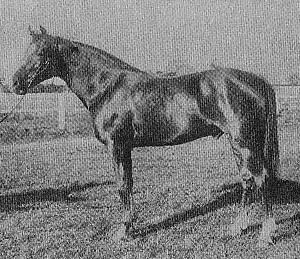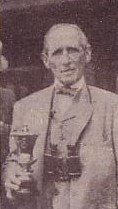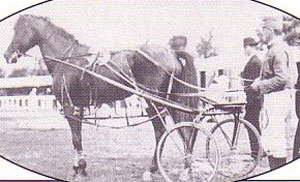| HORSES |
YEAR: 1903
 |
Bred in California in 1903 Harold Dillon was imported as a yearling by Mr E T Le Lievre of Akaroa who played a major part in the development of the standardbred at that time. What Mr Le Lievre's reactions were when he first saw his new purchase cannot be guessed at but Harold Dillon turned out to be a very small horse and he never grew a great deal, being little more than a pony until the day he died.
Tried as a racehorse Harold Dillon was not a success but his breeding future received a boost when a member of his first small crop (he was used at the stud before he was 2 years old) won the Futurity Stakes at the Addington Easter meeting of 1909 which was an important race in it's time. This was Dillon Bell who reached the best classes, and another to do well from an early crop was Moa Bell who also won a number of races.
Harold Dillon had mixed patronage early on but once he was transferred to the Santa Rosa Stud at Halswell near Christchurch under a master horseman in Bob McMillan his stocks received a boost. Like many sires some of his stock acquired doubtful reputations which for a time threatened his own career but in the end his progeny were so successful on the track that he downed the critics and became a great sire.
Harold Dillon was leading sire for five seasons from 1916 until 1921 taking over from Rothschild and conceding leadership to Logan Pointer though he was second and third to that sire for a number of years.He produced 182 individual winners which was an excellent record for the day. His best one was the brilliant Author Dillon the Robalan of his time whose record of 18 wins and 14 placings would have been much better but for the ridiculous handicapping of the day which saw him giving away long starts to good fields. He won three NZ Free-For-Alls and was virtually unbeatable in these types of races. Like all the Harold Dillon breed he was as tough as old boots and raced from three to nine years for his record. He was a top juvenile pacer as well and was a surprising success as a sire, his mares going particularly well, producing among others Marlene (NZ Cup), Indian Clipper and Knave of Diamonds. He himself sired among others Queen Auditor who won 13 races and produced the top mare of the 50s in White Angel.
Cello Sydney Wilkes, himself little more than a pony was another top winner for Harold Dillon and among his 11 wins was the feat of winning four races at the Cup meeting which only one other horse has done, this being Cardigan Bay. Adonis another stallion on the small side was perhaps the best pacer of them all and was also a successful sire featuring prominently in the Misfortune family. Waitaki Girl by Harold Dillon won 14 races and nearly $12,000 in stakes winning the feature race at the Canterbury Park Winter Meeting four years in succession. Some of the Harold Dillons were great mudlarks one being Sungod who reached Cup class and was placed in that event. Sungod was a sire of note himself and sired All Sunshine, an ancestress of Lunar Chance.
John Dillon was another top class pacer and quite the fastest beginner seen up to his time. He started in several Cups but was a better sprinter than a stayer. The late 'Dil' Edwards claimed that John Dillon once did a quarter in 28 seconds in training at Addington which was sensational in those days. Other Cup class performers by Harold Dillon were Antonio Oinaki (also a successful sire) Dolly Dillon and Lord Dillon.
As a broodmare sire Harold Dillon was also successful his daughters producing over 200 winners, though he was more successful with his male line than some imported sires. Two from Harold Dillon mares were Pot Luck and Parisienne winner and runner-up in the 1938 Inter-Dominion Championship. Dilworth was a national recordholder and Reporter a top class performer, Grace Dillon was the grandam of Roschana the dam of Cardinal Garrison. Highland Princess was the dam of the winners of 31 races. Eileen Dillon was the dam of Acuity (7 wins) who in turn produced Poranui and the champion Australian pacer Jackie Scott. Prolific was the dam of Manoeuvre who won eight races while Tatsy Dillon who herself won the Dunedin Cup is the founder of a successful family including Tatsydale and the good trotters Merrin and Ali Bey.
Connie Dillon was a great producer for the Benny family of Springston and included in her offspring or descendants are Gold Peg (9 wins) the grandam of the ill-fated Balcairn, Royal Fame (8 wins) Royal Counter (10 wins)and others. Sakatawea the dam of Star Classic belongs to this family. Another successful Harold Dillon mare was Flossie Dillon dam of Sonoma (Methven Cup), Tom Thumb (8 wins) and Pat Dillon ancestress of a champion trotting family including Waitaki Hanover of whom she was grandam. Protector, the sire of Nigel Craig has Harold Dillon blood through his 3rd dam Muriel Dillon.
At Santa Rosa where Harold Dillon stood for most of his career until his death in 1929 there are no horses now, just rows and rows of houses. The stud may have gone and Harold Dillon may have gone but his influence on our bloodstock cannot be erased nearly as easily.
-o0o-
David McCarthy writing in NZ Trotguide 18Nov76
We cannot let the stud career of Harold Dillon go without adding to his list a mare which we inadvertently missed at the time. This was Mirie Dillon who founded a line of fine winners for Colin McLaughlin of Mt Hutt. She was the grandam of Allakasam and ancestress of Royal Ascot. Adding further to his list was Sadie Dillon the dam of the 1923 Cup winner Great Hope.
Credit: NZ Trotguide 11Nov76
YEAR: 1984
 |
In 1836 a French whaling boat sailed in and around the bays of Banks Peninsula and dropped anchor at the sight which probably impressed those aboard most...Akaroa. The French whalers stayed for several months and one of them, Francois Le Lievre must have been particularly pleased with what he saw, because a year later he was among 63 passengers on board the Comp de Paris, the first settlers' boat from France.
Francois set about establishing the most successful farm on Banks Peninsula and marrying Rose de Malmanche, who had also arrived on the Comp de Paris. Francois and Rose raised several children, but it was Etienne who inherited his father's love of the land, and it's horses. Etienne, who was born in 1854, was brought up in the days when the horse was mainly the mode of transport. His family regularly travelled the miles to the flatter land of Little River, where at picnic gatherings each farmer would bring his fastest horses to race. Naturally, Etienne followed with interest the progress of trotting in town, Christchurch, which by the turn of the century was going ahead in leaps and bounds.
It was obvious at the time that the early importations from America, the likes of Berlin, Childe Harold, Irvington, Vancleve and Wildwood, and mares like Jeanie Tracey and Woodburn Maid were responsible for considerable improvement in the local breed.
Having inherited the largest and most successful sheep farm on Banks Peninsula some years earlier, Etienne had the resources and time to make some excursions in this field himself, and in 1904 he began the long trip to California in search of quality young horses. In the company of Robert McMillan, a highly respected young American horseman who had been living at Halswell in Christchurch, Etienne returned to New Zealand with a yearling colt by Sydney Dillon, a six-year-old entire called Wallace L and a five-year-old mare in Muriel Madison, while McMillan was credited with purchasing the stallion Mauritius and the mare Miss Youngley.
The colt by Sydney Dillon, the sire of the first 2:00 trotter Lou Dillon (1:58.5), was Harold Dillon, NZ's champion sire for five years between 1916-17 and 1920-21. Harold Dillon sired some 190 winners including the public idol Author Dillon (1918 NZ Cup), as well as Waitaki Girl, John Dillon, Oinako, Sungod and Adonis, all among the best pacers of the day. Well over 200 winners came from Harold Dillon mares including Pot Luck, Parisienne, Glenrossie and Dilworth. Wallace L was only moderately successful at stud while Muriel Madison founded a very successful family, to which over 160 winners trace,including No Response and Koala King. Mauritius was exported to Australia in 1907 and wound up leaving around 120 winners while Miss Youngley was the granddam of 1923 NZ Cup winner Great Hope and is the ancestress of close to 100 winners.
In 1913, Etienne went back to California and purchased a two-year-old colt by Bingen called Nelson Bingen and three young mares, one of which was Berthabell. Stinted almost entirely over the years to Nelson Bingen, the leading sire here for two seasons, Berthabell was to prove one of the most remarkable broodmares in the history of standardbred breeding in NZ, and the founder of one of our largest maternal families. Belita and Belle Bingen were the other mares. Belle Bingen had been bred fron Berthabell in America in 1913, being by Bingen, and had arrived with her dam in 1914. Belle Bingen was crippled on the journey to New Zealand, however, and was put in foal as a two-year-old.
Berthabell had been in foal to The Harvester during the trip but upon returning to Akaroa the resulting foal lived only a few days. Etienne's poor luck was to continue, as in 1916 Berthabell foaled dead twins by Nelson Bingen. Then, the following year, Berthabell produced a colt to Nelson Bingen, the first of eight consecutive foals by the son of Bingen and eight consecutive winners. Worthy Bingen was unsound and very lightly raced as a trotter, starting 13 times over 4 seasons for four wins. Lightly patronised at stud, he sired 33 winners, including the champion trotting mare, Worthy Queen.
Then came the champion Great Bingen. Raced by Sir John McKenzie and Dan Glanville, who bought him from Etienne as a two-year-old for £400, Great Bingen won £14,920, a stakes winning record for several years. In NZ he raced 73 times for 22 wins and 26 placings, while he also contested the Australian Championship, the forerunner to the Inter-Dominions, in Perth in 1926, recording four wins before being just beaten by Taraire in the final. While Great Bingen was the best pacer during the late 1920s, his younger brother Peter Bingen was also acquitting himself well in the tightest class. As a nine-year-old, starting from 48yds, Great Bingen was just beaten by Peter Bingen in the NZ Cup, the first of two wins in the event for Peter Bingen. Peter Bingen raced 87 times for 16 wins and 24 placings, for stakes worth £8629, a little more than half Great Bingen's earnings. Great Bingen later sired 46 winners, including Double Great (1935 NZ Derby) and Taxpayer (1932 Sapling Stakes, NZ Derby), while Peter Bingen sried 45, including top pacers Peter Smith, Double Peter and King's Play.
After them came the fillies Bessie Bingen and Bertha Bingen, who were lightly raced as pacers, each winning twice. Great Peter (eight wins, GN Derby), Baron Bingen (seven wins) and the trotter Great Nelson (five wins) completed the remarkable record of Nelson Bingen and Berthabell. Mated with Guy Parrish, Berthabell left the leading northern pacer Great Parrish, who won 14 races and £3317, taking the 1929 Great Northern Derby and 1932 Auckland Cup. He sired 41 winners. Sent back to Nelson Bingen in 1927, Berthabell left the filly Bell Nelson, who was unraced. The Guy Parrish filly Corona Bell followed, winning once as a trotter.
Travis Axworthy, whom Etienne had imported in 1924 along with Guy Parrish, was the sire of Berthabell's 1930 foal, the colt Ring True. Raced from age three until 11 in the north, Ring True won nine races and £2029, and later sired 46 winners. Ring True had his last start on February 14, 1942, 21 years and one week after the first of Berthabell's progeny, Worthy Bingen, made his debut, finishing third in the 1921 NZ Trotting Stakes at Forbury Park.
The 11 winning progeny of Berthabell had won 94 races and stakes worth £35,335, a figure by today's standards that would run well into the millions.
Credit: Frank Marrion writing in NZ Trot Calendar 11Sep84
YEAR: 1912
 |
| Albert H & A Hendriksen |
The influence of Rothschild in the early part of the century was never more evident than in the outcome of the 1912 New Zealand Cup, an in the composition of the field that went to the post.
The first three placed horses - Albert H, Ravenschild and Glendolough - were all by Rothschild. this outstanding achievement was later equalled by Light Brigade in 1957, when his progeny - Lookaway, Thunder and La Mignon - were the first three past the post. With the exception of Quincey, who was by Vancleve, all the other 15 acceptors in 1912 were descendants of either Rothschild or Prince Imperial. The latter had four representatives, while Rothschild had seven of his own, three by his sons and one by a grandson.
Albert H, a seven-year-old bay horse, was Rothschild's second New Zealand Cup winner, the first being Belmont M, in 1906. Driven a patient race by his trainer Albert Hendriksen, having his first Cup experience, Albert H came with a determined run in the final stages to win going away by two lengths. Ravenschild (Free Holmes)took second, with four lengths to Glendalough. Albert H paced the two miles in 4:48.8. Emmeline stood alone at the back on handicap, with her nearest rivals, St Swithin and Aberfeldy, five seconds away. The front-runners Medallion, Manderene, Ravenschild and Piecework started from nine seconds. Albert H was one of seven who started from eight seconds.
Albert H was the season's leading money-winner with £881. He was started only twice in the 1911-12 season - at the Canterbury Park meeting the previous June - and had won on both occasions in heavy ground. In August of the current season he was second in the King George Handicap, and the same afternoon won the International Handicap, over a mile-and-a-quarter. Despite this form he started seventh favourite in the Cup.
His dam, Jessie M, was by a thoroughbred horse, Son Of A Gun, who had placed second in the 1888 New Zealand Galloping Cup. Originally 18 horses had been accepted for the 1912 Cup, but Silver Princess and Lady Clare were withdrawn. Altogether 128 runners were accepted for the first day's racing, providing eight capacity fields.
St Swithin was made Cup favourite, Auckland pacer Manderene was second Choice, and Redchild, a trotter, was the next-best supported. However, all three failed to pay a dividend. The start was a shambles. Harry McNae's Gold Bell broke and collided with St Swithin, who dislodged his driver, Andy Pringle. Manderene also broke badly at the start. Bright stumbled after half-a-mile and was pulled up, and Medallion became another casualtywhen he broke and was pulled up near the mile post. So, again, the race was not a good one, with many horses not performing up to their handicaps, and the field was well spread over most of journey.
Showers on the second day made the track heavy. in the main race Adonis (Free Holmes), by Harold Dillon from Thelma, thereby a half-brother to Wildwood Junior, beat Sparkling Kola and Quincey. One of the two trotters who had contested the Cup, Quincey improved on his run when he beat the pacers on the third day, in the Courtenay Handicap. The Vancleve stallion ran an excellent 4:38, 10 seconds faster than the Cup time of Albert H. Master Raymond won the Dominion from Muricata and Kelso, taking 4:52.2 to trot the two miles.
The early indications were that the 1912 meeting would be a successful one, and so it proved. Totalisator returns on Cup Day smashed all records. Betting reached £32,969, with £7053 invested on the Cup. The turnover for the three days was £99,177, well within reach of the club's next milestone, £100,000.
Two alterations greeted patrons when they arrived at Addington for this meeting. The club had put up a large board, visible from all parts of the ground, on which were the names of the riders or drivers. Because of the growing importance of vehicular traffic, the club had bought more land and built a special roadway and entrance for all vehicles.
Harry Nicoll was the top owner for the third consecutive season with £987, well down on the £1547 and £1222 he had won in the previous two seasons.
Credit: Bernie Wood writing in The Cup